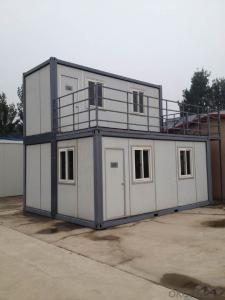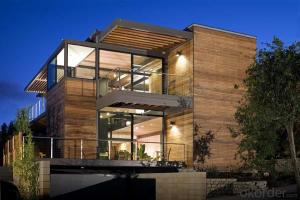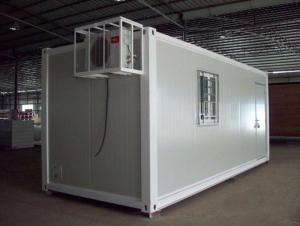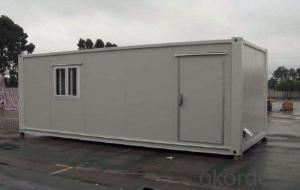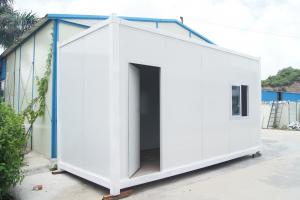Steel structure prefabricated container wall sandwich panel mobile homes
- Loading Port:
- China Main Port
- Payment Terms:
- TT OR LC
- Min Order Qty:
- -
- Supply Capability:
- -
OKorder Service Pledge
OKorder Financial Service
You Might Also Like
Specifications
1low cost modular house. low cost
2. easy installation
3 Green and environmental material
4. Power-Saved
Specifications
1. Firm structure and multiple use.
2. Lost cost and convenient in shippment.
CNBM INTERNATIONAL LOW COST PREBUILT CONTAINER HOUSES
Product description
1. Container house is a unit house with the size of 6055mm*2435mm*2740mm.
2. The container house adopts EPS, glass wool or rock wool as heat insulation material.
3. All the components are standard and prefabricated with the advantage of assembling and disassembling easily. Six skilled workers can finish three modular units in 8 hours.
4. 4sets of standard container house can be packed together to replace the shipping space of one 20ft container.
5. The container house can be linked freely at length, width and height through the linking kits for bigger structure and different layout.
6. Waterproof design of galvanized structure, fireproof and heat insulation of material ensure the house to resist heavy wind load of 0.6KN/m2and 8 degree seismic intensity.
7. The life span of the house is 20-25 years.
Characteristics
1. Cost Effectiveness
2. Chemical free, and lower waste
3. Easy to erect
4. Safety
5. Fireproof, termite free
6. Strong and durable – weatherproof, anti-seismic
7. Materials will not shrink, rot or warp
8. Pre-galvanized for rot and corrosion prevention
Benefits of factory built prefabricated houses and villas
| |
Very little maintenance | Reduce environmental pollution and save water |
Ease and speed of erection | Easily transportable |
Aesthetically pleasing | Buildings can be relocated |
Priced more economically than brick | Buildings can be designed by your choice
|
- Q:How do container houses handle extreme weather conditions?
- Container houses are constructed with a strong and durable framework, making them capable of withstanding harsh weather conditions. Typically, these houses are made from sturdy steel shipping containers that are specifically designed for ocean transport. The steel construction of these containers provides a robust framework that can endure high winds and severe storms. To further enhance their ability to withstand extreme weather, container houses often undergo modifications. These modifications may involve reinforcing the walls, floors, and roof with additional steel beams or adding insulation to improve thermal resistance. Additionally, reinforced windows and doors are installed to offer better protection against strong winds and heavy rain. Furthermore, container houses can be designed to either elevate or anchor them to the ground, depending on the location and potential weather threats. Elevating the house can protect it from flooding, while securely anchoring it to the ground ensures stability during periods of high winds. Moreover, container houses can be equipped with weather-resistant features such as hurricane shutters or impact-resistant glass to safeguard against extreme weather conditions like hurricanes or hailstorms. These features play a significant role in minimizing damage and ensuring the safety of the occupants during such events. It should be noted that proper planning, design, and regular maintenance are crucial for container houses to effectively endure extreme weather conditions. Regular inspections and repairs are necessary to promptly address any wear and tear, thereby preserving the structural integrity of the house. Overall, container houses are designed to be resilient and can withstand extreme weather conditions through appropriate modifications and maintenance.
- Q:Can container houses be designed with a high ceiling?
- Certainly! Container houses have the potential to incorporate a high ceiling into their design. Their versatility allows for customization to cater to various design preferences, including the desire for a lofty interior. The specific height of the container house's ceiling hinges upon the modifications and design choices made during the conversion process. By either removing portions of the original roof or incorporating extension components, one can elevate the ceiling height, resulting in a spacious and airy atmosphere. Furthermore, container houses can integrate diverse roof types, such as gable or shed roofs, which further contribute to an increased ceiling height. Ultimately, with the proper modifications and design considerations, container houses can indeed possess a lofty ceiling.
- Q:Can container houses be built with a rooftop terrace or outdoor seating area?
- Yes, container houses can be built with a rooftop terrace or outdoor seating area. This is possible by modifying the container structure and adding additional support systems to accommodate these features.
- Q:Are container houses considered a sustainable housing option?
- Yes, container houses are considered a sustainable housing option. They are made from recycled shipping containers, reducing waste and utilizing existing resources. Additionally, their construction process requires less energy and materials compared to traditional houses. Container houses can also be designed to incorporate eco-friendly features such as solar panels, rainwater harvesting systems, and insulation for energy efficiency. Overall, container houses offer an environmentally conscious and sustainable alternative for housing.
- Q:Can container houses be designed with a small garden or outdoor space?
- Yes, container houses can definitely be designed with a small garden or outdoor space. In fact, many container house designs incorporate outdoor areas to provide residents with a connection to nature and additional living space. There are several creative ways to incorporate a garden or outdoor space into a container house design. One option is to utilize the rooftop of the container as a green space or terrace. This can be done by adding a layer of soil and planting grass, flowers, or even a small vegetable garden. Additionally, rooftop gardens can also help with insulation and reducing energy consumption. Another option is to design the container house with an attached or detached outdoor space, such as a patio or deck. This can be achieved by extending the structure of the container or adding additional modules. These outdoor spaces can be used for various activities like relaxing, dining, or even hosting small gatherings. Furthermore, container houses can also incorporate vertical gardening systems, which allow for plants to be grown vertically on the walls. This is a great option for those with limited outdoor space and can add a touch of greenery to the interior or exterior of the container house. In conclusion, container houses can be designed with small gardens or outdoor spaces. These additions not only enhance the aesthetics of the house but also provide residents with the opportunity to connect with nature and enjoy the benefits of outdoor living.
- Q:How are container houses built?
- Container houses are built using shipping containers that are typically made of steel. The construction process involves several steps. Firstly, the containers are carefully inspected to ensure that they are structurally sound and suitable for building purposes. Any damages or rust are repaired, and the containers are thoroughly cleaned. Next, the containers are modified according to the desired layout and design. This includes cutting out openings for doors, windows, and any other required features. Reinforcements are also added to ensure the structural integrity of the containers. After the modifications, the containers are transported to the building site and placed on a solid foundation, such as concrete pads or steel beams. The containers are then securely welded or bolted together to form the desired layout. Once the containers are securely connected, the interior and exterior finishes are applied. This may involve insulation, electrical wiring, plumbing, and HVAC systems to provide comfort and functionality. The walls, floors, and ceilings are finished with materials such as drywall, wood, or tiles, depending on the design preferences. Finally, the container house is painted or cladded to enhance its aesthetics and protect it from weather conditions. The finishing touches, such as fixtures and fittings, are added to complete the construction process. Overall, container houses offer a cost-effective and sustainable alternative to traditional construction methods. They can be built relatively quickly and are highly customizable, making them a popular choice for those seeking affordable and eco-friendly housing solutions.
- Q:Can container houses be transported overseas?
- Yes, container houses can be transported overseas. Due to their modular and stackable design, container houses are highly transportable and can be easily loaded onto ships for international shipping. The shipping containers used to build these houses are designed to withstand rough sea conditions and are built to international shipping standards, making them suitable for long-distance transportation. Additionally, container houses can be disassembled and reassembled at the destination, allowing for easy relocation and adaptability. However, it is important to consider the logistics and costs associated with overseas transportation, including shipping fees, customs regulations, and any necessary permits or approvals required in the destination country.
- Q:Can container houses be easily modified or remodeled?
- Yes, container houses can be easily modified or remodeled due to their modular nature. The ability to stack, interlock, and dismantle containers provides flexibility in design changes or expansions. Additionally, their steel structure allows for easy cutting and welding, enabling modifications such as adding windows, doors, or partitions.
- Q:Can container houses be customized?
- Indeed, individual preferences and needs can be accommodated through the customization of container houses. The modular structure of shipping containers enables straightforward modifications and adjustments, resulting in one-of-a-kind living spaces. Customization possibilities extend beyond altering layouts, including the ability to add or remove doors and windows, install insulation, and integrate diverse design elements. Moreover, container houses can be tailored to incorporate sustainable features like solar panels, rainwater harvesting systems, and green roofs. The boundless potential for customization offered by container homes has contributed to their popularity among individuals searching for a personalized and environmentally conscious living solution.
- Q:Are container houses suitable for areas with strict HOA regulations?
- Container houses can be a suitable option for areas with strict HOA regulations, but it will depend on the specific requirements and restrictions set by the HOA. While container houses may not fit the traditional aesthetic of many neighborhoods with HOA regulations, they offer several advantages that can make them a viable option. Firstly, container houses are often more affordable compared to traditional stick-built homes. They can be a cost-effective solution for people looking to build a home in areas with high property prices or limited housing options. This affordability factor may make container houses an attractive option for some homeowners. Secondly, container houses are known for their durability and sustainability. Containers are built to withstand harsh conditions during transportation, which makes them resistant to extreme weather conditions and natural disasters. Additionally, repurposing shipping containers reduces waste and contributes to a more environmentally friendly approach to construction. However, it's important to note that container houses may require some modifications to meet the specific regulations set by the HOA. These modifications can include changes to the exterior appearance, landscaping, or even the overall layout of the house. Homeowners must thoroughly review and understand the HOA guidelines to ensure compliance. Furthermore, it is advisable to engage in open communication with the HOA board and seek their approval before proceeding with a container house project. Demonstrating the benefits, addressing any concerns, and providing detailed plans can help persuade the HOA to consider allowing container houses within their regulations. In conclusion, container houses can be suitable for areas with strict HOA regulations, but it requires careful consideration, adherence to guidelines, and open communication with the HOA. The affordability, durability, and sustainability aspects of container houses can make them an appealing option for homeowners, but it's essential to ensure compliance with the specific regulations set by the HOA.
1. Manufacturer Overview |
|
|---|---|
| Location | |
| Year Established | |
| Annual Output Value | |
| Main Markets | |
| Company Certifications | |
2. Manufacturer Certificates |
|
|---|---|
| a) Certification Name | |
| Range | |
| Reference | |
| Validity Period | |
3. Manufacturer Capability |
|
|---|---|
| a)Trade Capacity | |
| Nearest Port | |
| Export Percentage | |
| No.of Employees in Trade Department | |
| Language Spoken: | |
| b)Factory Information | |
| Factory Size: | |
| No. of Production Lines | |
| Contract Manufacturing | |
| Product Price Range | |
Send your message to us
Steel structure prefabricated container wall sandwich panel mobile homes
- Loading Port:
- China Main Port
- Payment Terms:
- TT OR LC
- Min Order Qty:
- -
- Supply Capability:
- -
OKorder Service Pledge
OKorder Financial Service
Similar products
New products
Hot products
Hot Searches
Related keywords
